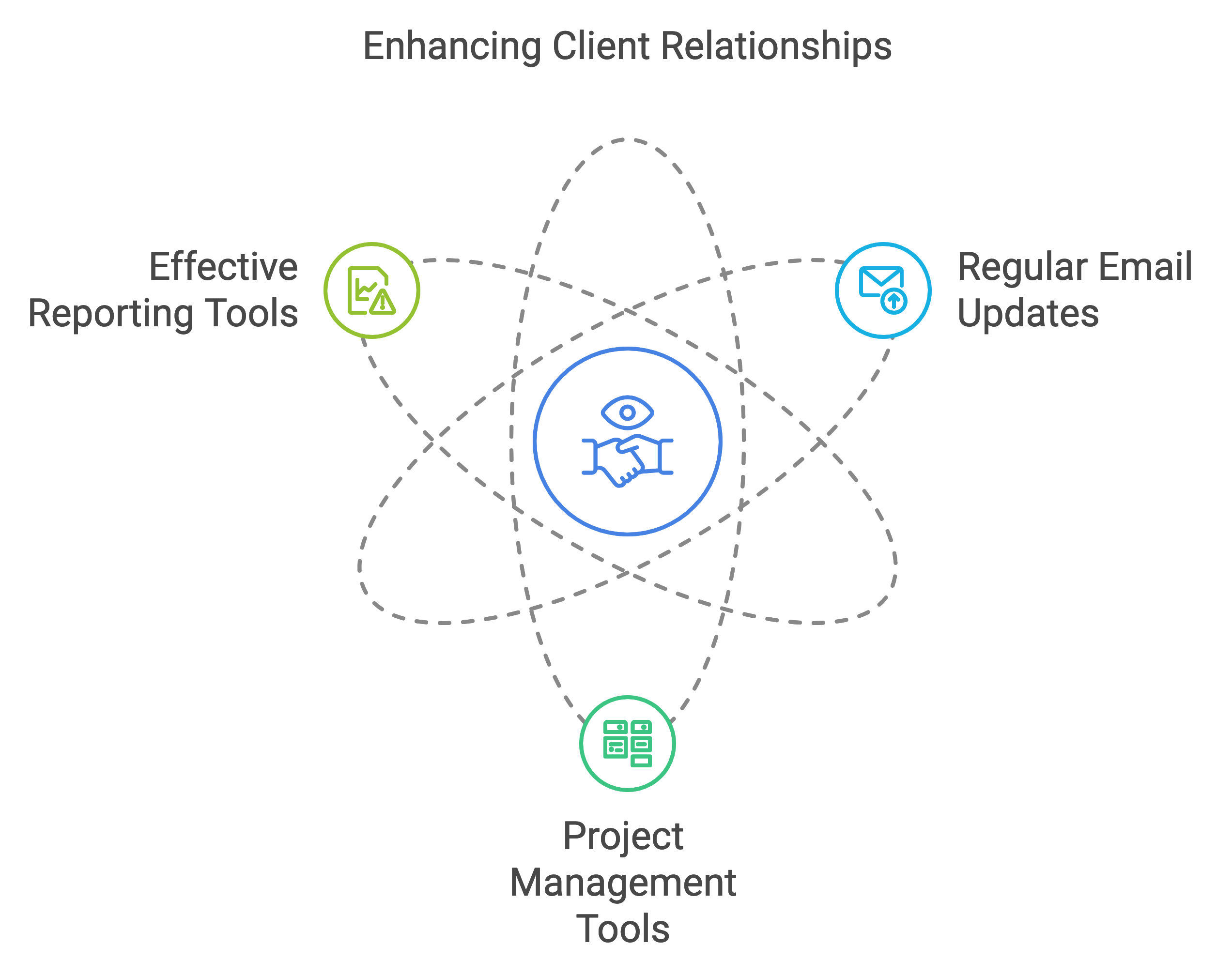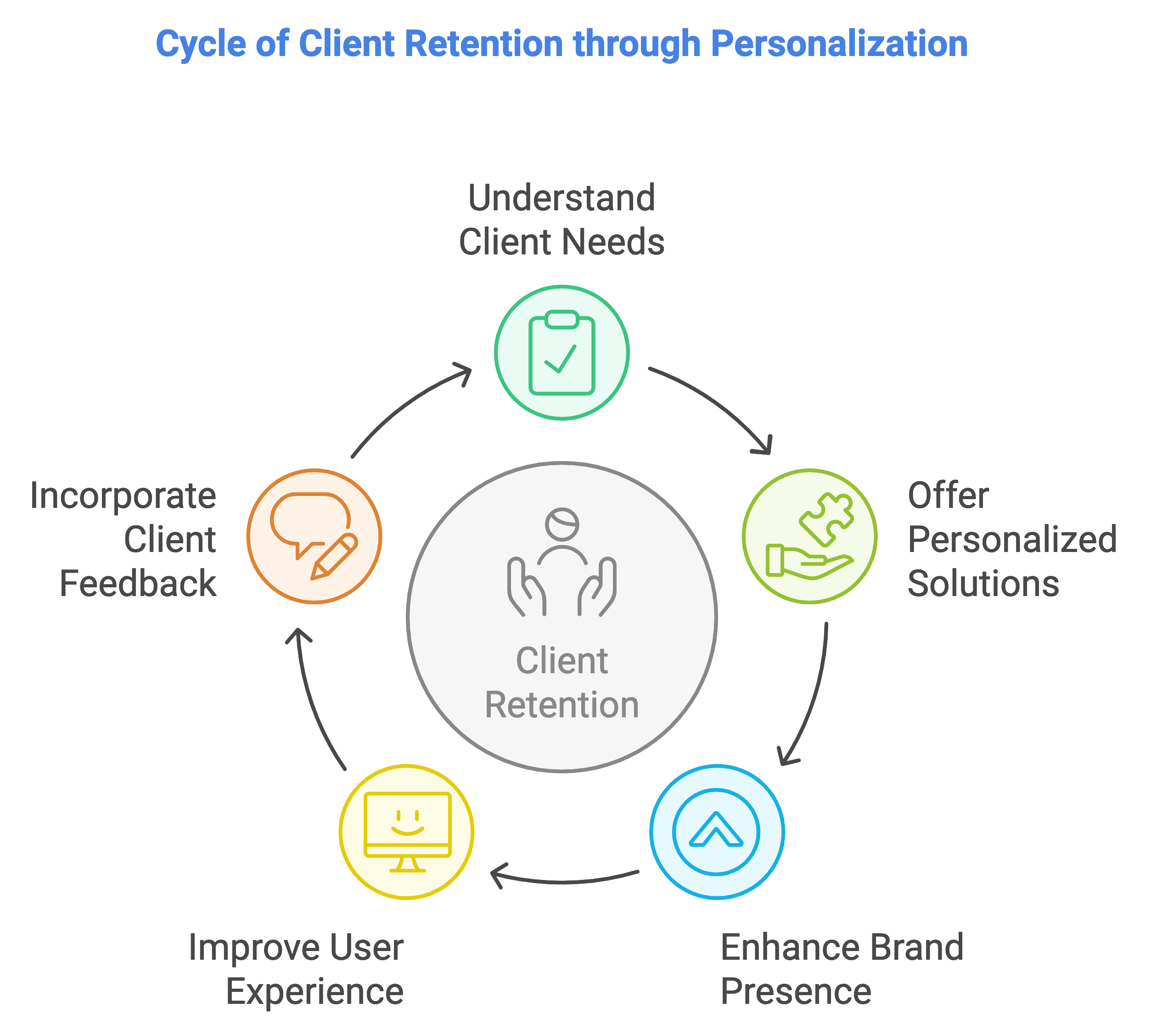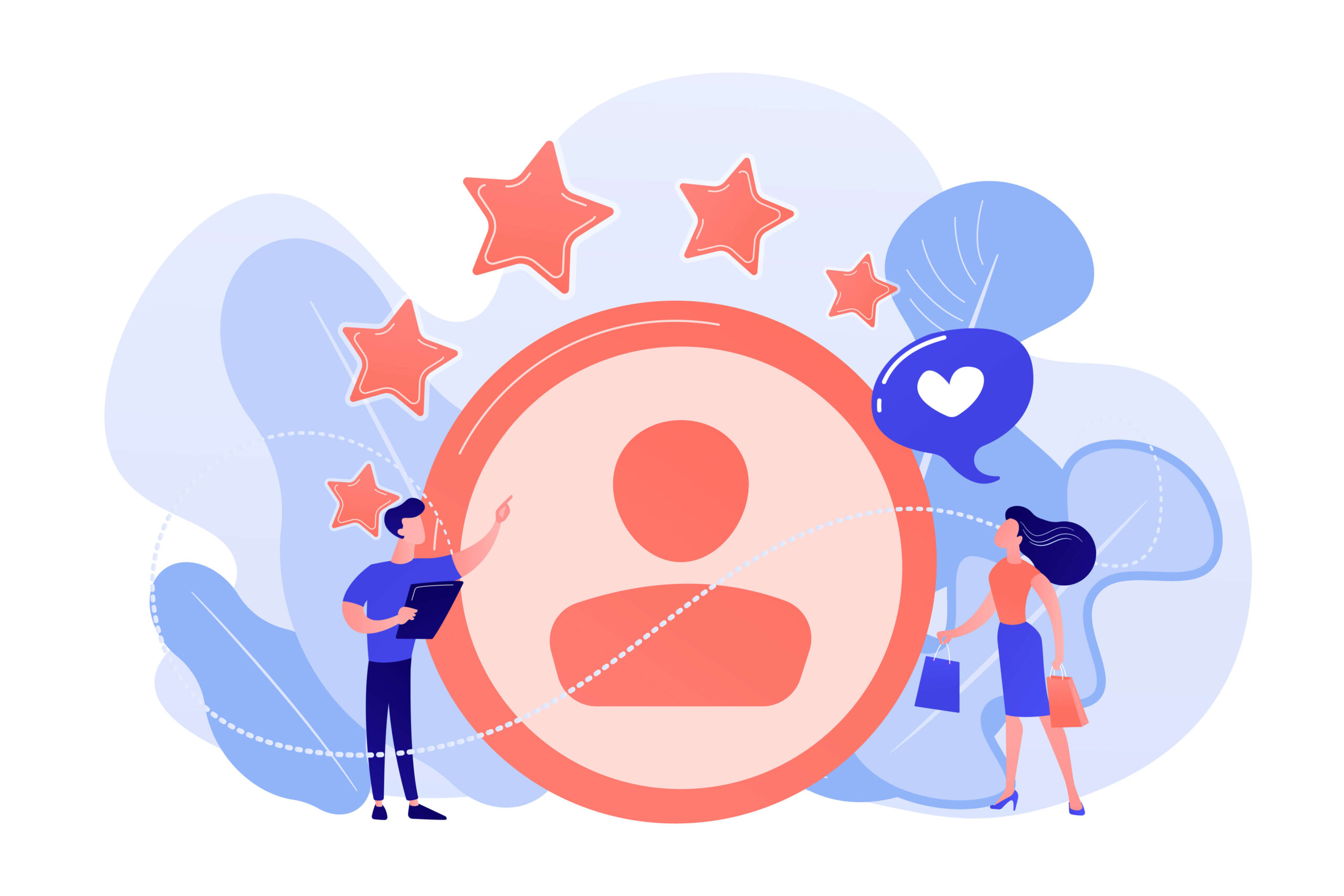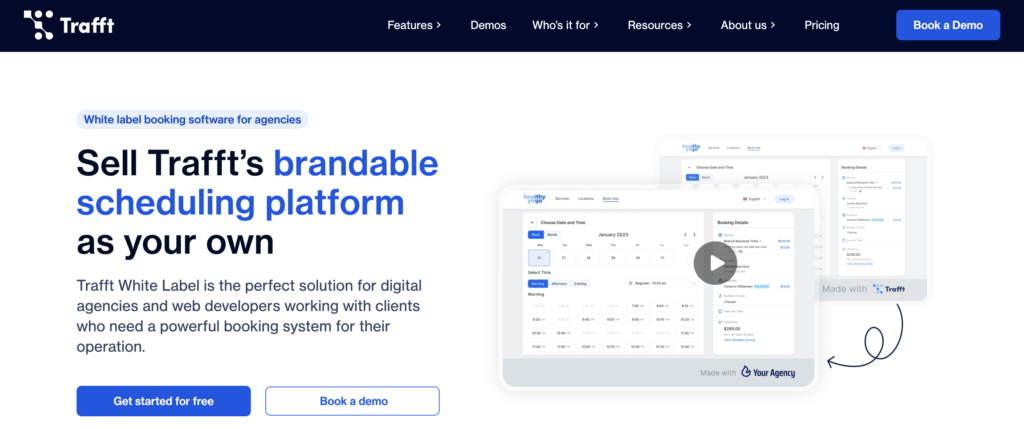Keeping your clients happy is not just about doing a good job when providing them with services. Have you ever wondered why some businesses have clients coming back, while others struggle to make loyal clients?
The cornerstone of your agency should be to do a good job, but there are a few more tips and tricks you can focus on to ensure your business stability and growth. Beyond the basic delivery of quality services, successful client retention strategies involve fostering strong, ongoing relationships that add value.
Let’s explore in detail how to ensure a return visit from a client and effectively convert first-time clients into loyal, returning customers!
Retention Tactics for WordPress Development Agencies
Regular communication and transparency
Building a trusting relationship with your clients starts with consistent communication and transparent reporting. It’s very important to keep your clients updated and well-informed about the progress of their projects. This gives them reassurance but also strengthens their confidence in your agency.
How to implement efficient communication and transparency?
- Regular email updates: Set a routine of sending periodic email updates. Summarize recent developments, outline next steps, and highlight any important issues or decisions that require client input.
- Project management tools: Use project management tools to provide a visual and interactive overview of project status. Try using Trello or Jira, these tools can help clients track progress in real-time and feel more connected to the workflow.
- Effective reporting tools: Use tools such as Google Analytics for traffic insights, SEMrush or Ahrefs for SEO analytics, and Zoho Reports for customizable data reporting. With these tools, you can provide clear, concise, and actionable insights to your clients, demystify complex data, and enhance client transparency.
Transparent communication and detailed reporting can help in converting existing clients to return clients. Not only will they receive a well-done project, but will also feel valued throughout your collaboration.

What does monthly reporting actually look like?
Let’s say you’re managing a digital marketing campaign for a client aiming to boost their brand’s visibility. At the beginning of each month, you should send a detailed email update outlining the results from the previous month, the planned activities for the coming month, and any adjustments based on performance data.
You should also invite clients to your project management tool – say Trello or Asana – to enhance transparency. Here, they can see the campaign milestones and track the tasks your team is working on in real-time. In this space, you include campaign goals, deliverable timelines, and checklists for upcoming ad launches, content, and any adjustments to strategies.
For reporting, you set up a dashboard in Google Data Studio that automatically pulls in data from Google Analytics, SEMrush, and Ahrefs. This dashboard is also shared with the client and updated weekly, giving them immediate insight into key metrics, like traffic growth, top-performing keywords, and conversion rates.
During your monthly check-in call, you walk through the dashboard with them, explain what’s going well, and highlight areas for improvement or potential changes.
This combination of proactive email updates, real-time project tracking, and accessible data reporting keeps the client engaged and informed, making them feel like a valued partner in the project’s success.
Ongoing website maintenance & support packages
Another strategy for boosting your client retention rates is to provide ongoing website maintenance and support. Continuous services such as software updates, backups, and security checks are a perfect way to enhance client satisfaction and foster long-term loyalty.
Be your clients’ digital bodyguard – offer services that ensure their website operates smoothly. is secure from various threats, and stays up to date with the latest technology and trends. This way, you’ll show them your commitment to their website’s longevity and effectiveness.
Think about creating tiered support packages that suit different levels of client needs. With different packages, everyone can choose one that aligns with their budget and specific requirements, ranging from basing maintenance to premium options. These advanced packages can include features like performance optimization, SEO improvements, and bespoke development.
If you offer varied support levels, you can accommodate a broader spectrum of clients while establishing predictable, recurring revenue streams.
What does ongoing support look like in practice?
Let’s say a local boutique online retailer has contacted you regarding the issues with slow page loading time during peak sales periods, which has led to a decrease in customer satisfaction and potential lost sales.
If you offer one of your support packages, they benefit from regular website performance optimizations and advanced caching solutions to handle increased traffic. Plus, you can schedule bi-weekly security checks to ensure their website remains secure against new vulnerabilities, which is especially important as their customer base grows and data privacy becomes a bigger concern.
This way you improve their website’s performance and give your client a piece of mind, knowing they have a dedicated team monitoring their site’s health and are ready to react promptly. Moreover, implementing a reliable PSA software can streamline your client management processes and help you efficiently monitor and respond to website performance issues.
Customization & personalization
Customization and personalization are some of the best ways to retain clients in any business. It’s important to understand and address each client’s specific needs to keep them coming back. One size doesn’t fit all, so if you offer personalized solutions you show your clients you care and actually want to help them.
For example, custom plugins or designing custom themes that reflect a client’s corporate colors and style can enhance their brand’s online presence. Tailor-made solutions can also improve user experience and functionality of the website, directly impacting customer satisfaction and engagement.
Listen to your clients’ wishes and actively incorporate their feedback into your service offerings. This will show them that their input is valued and important to your business operations.

How does a customized approach help your clients?
Let’s say a coffee shop wants to expand their online store to include subscription services for their bespoke blends. You can design a custom plugin that integrates a subscription management system into their existing WordPress site.
This plugin is tailored to handle recurring orders, and customer preferences for grind type and delivery frequency, and even includes a feature for customers to pause or change their subscription details easily. This way you fulfill their immediate needs but also establish a foundation for ongoing collaboration, as they see you as their partner that works towards their needs and goals.
Educating clients on new trends
Why would clients come back if they don’t know about all new developments that can help them? That’s why it’s your job to inform them about the latest practices and trends in technology.
The newest WordPress updates, SEO best practices, and relevant industry trends will empower them to make informed decisions, and they will value your engagement with their business.
Use these several educational tools:
- Newsletters: These are great for keeping clients up-to-date. You can include summaries of recent changes in WordPress, insights into SEO enhancements, or general tips on digital marketing that might affect their strategy.
- Webinars: Hosting webinars can be an interactive way to educate your clients about the latest trends. You can dive deep into topics of interest, demonstrate new features, and allow real-time Q&A.
- Blog posts: Nothing beats a good educational blog post. Detailed articles on specific trends, updates, or best practices offer your clients a resource they can refer to at any time. You can show practical examples of how these trends can be applied, and explain complex topics in layman’s terms.
Offering value-added services
Adding services that provide more value to your clients is a great way to show them you actually care about their website’s functionality. SEO optimization, content updates, or custom integrations can make big changes and help improve various aspects of a website’s performance.
For example, offering regular content updates will make sure the website stays relevant and engaging for the visitors, but will also maintain its authority and rankings on search engines. These updates can include blog posts, case studies, and even refreshing old content to align with current trends and data.
Value-added services are going to be useful only if you listen closely to your clients and their needs. So, custom integrations such as e-commerce solutions, CRM systems, or automated marketing tools streamline operations and improve user experiences. The result is an efficient website, enhanced user satisfaction, and a happy client!
How can value-added services help your clients?
For example, an online shop wants to expand their online presence, and while their website is functional, you find out that it hasn’t been updated in terms of content or SEO practices in a while.
You can propose a content update plan that includes monthly blog posts highlighting new trends in their industry, customer stories, and similar, to keep the website dynamic and engaging. You can also suggest refreshing existing content to meet current SEO practices.
Next, you can offer to integrate their existing e-commerce platform with the latest CRM tools to streamline customer interaction and automate marketing tasks. For instance, a CRM tool that segments customers based on purchase history and preferences can allow personalized email campaigns and promotions, enhancing retention and sales.
If you offer value-added services that are tailored to their specific needs you demonstrate a deep understanding of their challenges and a commitment to help them grow.
Loyalty programs & discounts for long-term clients
One of the best client retention strategies is to reward long-term clients and reinforce their collaboration with your agency with loyalty programs and discounts. This way, you will show appreciation for client loyalty but you will also encourage ongoing engagement and contract renewals.
There are several ways you can structure loyalty programs effectively:
- Tiered discounts: Implement a tiered discount system where the discount percentage increases with the client’s tenure or the number of projects they undertake with your agency. For example, offer a 5% discount on services after one year, 10% after two years, and 15% after three years. This will encourage clients to maintain their relationship with your agency over a longer period.
- Point system: Introduce a point system where clients earn points for each project they complete or each dollar they spend. These points can be redeemed for services like additional site customization, a free month of maintenance, or training sessions on how to use new WordPress features.
- Referral rewards: Encourage clients to refer new customers by offering them service credit or discount each time a referral results in a new client signing. This will expand your client base and encourage existing clients to participate in your agency’s growth.
- Annual rewards or upgrades: Offer to review a client’s website once a year, and offer suggestions for improvements and upgrades. Clients who have been with you for more than a year can receive these updates at a discounted rate, or even free, depending on their loyalty status.
Retention Strategies for Different Types of Clients
Small business clients
For small businesses, you have to offer solutions that align with their budget but still provide significant value. You can achieve this by offering bundled services, which combine several essential services into a single package at a discounted price. This will allow small businesses to afford a comprehensive service that covers all their basic needs without financial strain.
A basic bundle of website hosting, basic SEO optimization, and monthly content updates can ensure that a small business website remains functional, optimized, and fresh.
Plus, if you offer manageable website updates as a standalone service this can also keep small businesses engaged. Instead of overwhelming them with large-scale redesigns, focus on small improvements that are both affordable and impactful. You can do this by optimizing their landing page, adding a new section to the site, or updating the user interface to improve usability. Small updates like this will keep the website functional, and user-friendly, but will also cater to small businesses’ budgets.
Enterprise-level clients
These clients require a bit more customization and a sophisticated approach. They usually look for solutions that are specifically tailored to integrate seamlessly with their existing operations. This could include developing custom plugins or themes that align with their brand or creating unique integrations that connect their WordPress site with enterprise resource planning systems, customer relationship management tools, or other enterprise applications.
Good and comprehensive analytics are also crucial for enterprise clients. You have to do detailed reports and data-driven insights that inform strategic decisions and improve business outcomes. User behavior analysis, conversion tracking, and performance benchmarking against industry standards can significantly enhance their understanding of how well their digital strategies are performing.
Non-profit or niche businesses
Non-profit and niche businesses require even more personalization to match their unique missions and objectives. First off, understand their specific goals, which will guide the creation of specialized solutions such as cost-effective web enhancements for non-profits, or unique functionalities for niche businesses to support their industry needs.
Non-profit businesses often have budget constraints, so offering services at a reasonable cost or with a discount is crucial. It’s also important to clearly communicate the impact of your services, and provide metrics and reports that illustrate improvements.
Educational support is also important. You can provide training to help clients manage the tools and systems you implement. This empowers them and maximizes the value of their investment. Lastly, position your agency as a long-term partner by offering ongoing support and adapting strategies to meet evolving challenges and opportunities.
Leveraging Technology for Better Retention
Automation tools for client communication
To enhance client retention, you need communication and project reporting tools. These tools will streamline the communication process, ensuring the information is consistent, timely, and accessible, which in turn helps clients feel more connected and valued.
Slack is a powerful tool for real-time updates in communication. It can also be integrated with various management tools to keep clients updated on the progress of their projects. For example, integrating Slack with platforms like Trello or Asana allows for automatic notifications when tasks are updated or milestones are reached.
On the other hand, email is always a great way to update clients. Try Mailchimp or SendGrid for scheduled updates and reports. These tools can be set up to automatically generate emails based on specific triggers or stages of the project. This way, your clients will receive regular and informative updates.
Streamlined booking: A win-win for you and your clients
As a WordPress agency, you’re not just building websites—you’re providing solutions that make your clients’ lives easier. For service-based businesses like salons, gyms, or clinics, a reliable booking system is essential. When you offer a seamless, built-in booking solution as part of your website package, you’re not only saving your clients the hassle of finding one themselves but also setting up a key feature that keeps clients coming back to you.
Boost retention with a branded, white-label solution
Imagine if every time your clients booked an appointment, they interacted directly with your brand. A white-label booking solution like Trafft lets you deliver a professional, cohesive booking experience under your own brand name. By offering this branded solution, you reinforce your agency’s identity at every point of contact, keeping your brand top of mind and setting yourself apart from competitors who rely on generic systems.
Trafft also gives you the flexibility to create a profitable revenue stream. You can set your own pricing model—whether that’s a one-time setup fee, monthly, or yearly subscriptions—and offer custom-tailored features to meet each client’s needs. With this solution, your agency gains control over the booking experience, helping clients save time while deepening their loyalty to your brand.
Incorporating a branded booking tool not only brings new clients in but strengthens relationships with existing ones, building trust, reliability, and a reputation for professionalism that keeps clients coming back.
Using analytics to understand client behavior
For successful client retention and tailored services, you need to understand their behavior and needs. With these tools, you can get a wealth of data that can reveal patterns, preferences, and pain points from actual user interactions.
Website analytics tools
Google Analytics is a fundamental tool that tracks and reports website traffic. You can see which pages are most visited, how much time clients spend on each page, and how they navigate through your site. This will help you identify what attracts clients and where they might be experiencing issues.
Hotjar can give you more nuanced insights, like heat maps, click maps, and visitor recordings. These features will show you exactly where users are clicking, how far they scroll, and how they interact with your website in real-time.
Client feedback tools
To improve yourself and retain clients, you must know how they feel about your agency. That’s why it’s smart to use SurveyMonkey or Typeform to create online surveys that can be integrated into your website or sent via mail to clients after a service is delivered.
These surveys can collect client feedback on various aspects of your service, and directly show you what they are satisfied with, and what they think could be improved.
UserVoice can also be a great place for client feedback. This feedback forum allows clients to communicate issues and suggestions directly, fostering a transparent and responsive environment. This direct line of communication helps clients feel heard and valued, ultimately strengthening client relationships and enhancing client retention.
So, How Do You Convert Existing Clients to Return Clients?
There is no one strategy that will help you ensure a return visit from a client. You need to incorporate a variety of approaches tailored to meet the specific needs and expectations of your clients.
The best way is to incorporate all of these elements into a cohesive client retention strategy. This way, you will make sure you did everything to increase the likelihood of clients returning. Remember, building a loyal customer base will drive long-term success for your agency!


